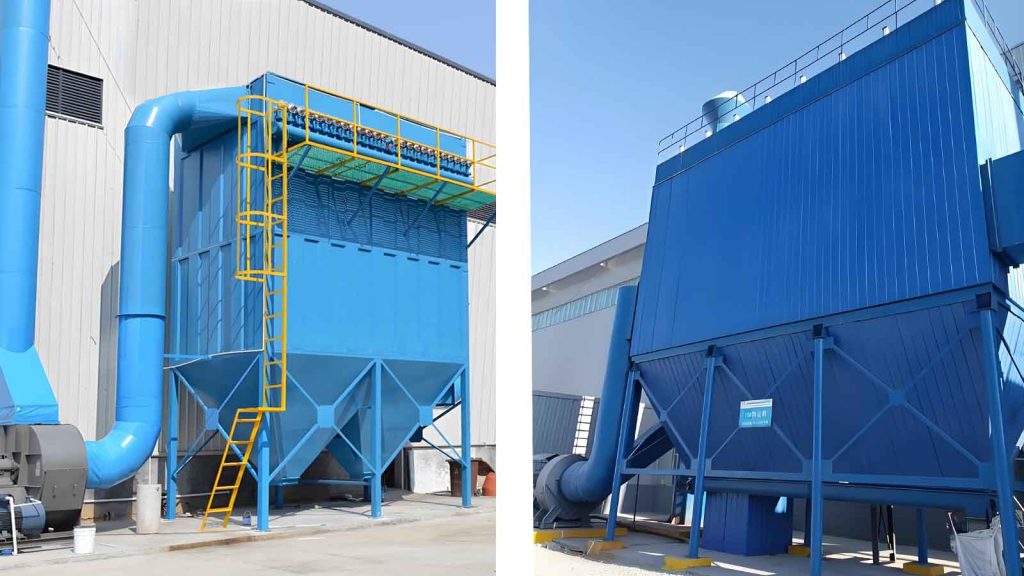A bag dust collector is a dry dust filtration device. It is suitable for capturing fine, dry, non-fibrous dust. The filter bags are made from woven filter cloth or non-woven felt. These bags use the filtration effect of fibrous fabric to filter dusty gas. When dusty gas enters the bag dust collector, large and heavy dust particles settle down due to gravity. They fall into the hopper. Then, the gas containing finer dust passes through the filter material. The dust is trapped, and the gas is purified.
Selection Basis
The air volume of a bag dust collector refers to the volume of gas it can purify per unit of time. You must design or select the collector based on this air volume. Generally, do not let the collector operate beyond the specified air volume. Otherwise, the filter bags may clog easily. Their lifespan will shorten. The pressure loss will rise significantly. Also, the dust removal efficiency will decrease. However, you should not select an excessively large air volume either. This increases equipment investment and floor space. Furthermore, it wastes resources and is not energy efficient.
Selecting a reasonable air volume often depends on the process conditions and experience. The inlet dust concentration directly affects the following factors:
Pressure Loss and Cleaning Cycle
A higher inlet concentration means dust accumulates faster on the same filter area. Consequently, the pressure loss increases. As a result, you must clean the bags more often.Operation Method
Bag dust collectors use two operation methods: positive pressure and negative pressure. To reduce fan wear, do not use the positive pressure method for high inlet dust concentrations.Need for Pre-dust Collection
Pre-dust collection means adding another dust removal device before the collector inlet. We also call this primary dust collection.Wear of Filter Bags and Housing
If the dust is highly abrasive, the wear amount is proportional to the dust concentration.Discharge Capacity of the Ash Discharge Device
The ash discharge device must handle all the collected dust. The total dust amount equals the inlet dust concentration multiplied by the air volume.
Outlet Dust Concentration
The outlet dust concentration is the emission concentration of the collector. We express it the same way as the inlet concentration. This outlet concentration must meet local environmental requirements or user demands. Typically, bag dust collectors can achieve an emission concentration below 50mg/Nm³.
درجة حرارة التشغيل
For a bag dust collector, the operating temperature depends on two factors. First, it depends on the maximum temperature the filter material can withstand. Second, the gas temperature must be above the dew point.
Currently, many systems use glass fiber filter materials. Their maximum operating temperature can reach 280°C. You must cool gases hotter than this. Conversely, you must heat gases below the dew point.
Bag Damage
We took samples from damaged bags for analysis. The results showed that the air permeability, burst strength, and break strength of undamaged areas were within acceptable limits. We also found that the damage was almost always 20-40cm from the bag opening. Furthermore, the wear started from the inside.
We determined the main cause was related to the reverse air system. First, the reverse air nozzles were misaligned, causing biased blowing. Second, the compressed air pressure for reverse blowing was too high.
We could modify the blowing system. However, this costs a lot and takes a long time. We could not finish it during a normal maintenance period. After study, we decided to add inner liners to the bags. This method is simple, easy, and low-cost.
Control the reverse air compressed air pressure between 0.25–0.35 MPa. This pressure should be enough to clean dust from the bags. Higher pressure harms bag life. Adjust the pressure based on the pressure difference across the collector. Keep the pressure difference within the required range (designed pressure difference <1700 Pa).
Adjust the blowing pulse width from 150ms to 250ms. This reduces the blowing force and decreases bag wear.
Compressed Air Shortage Trip
The filter element in the oil-water separator (between the air tank and the lift valve) clogged due to dirty compressed air.
After long-term operation, the seals in the lift valve wore out. This caused compressed air leaks and insufficient supply.

الحلول
Add a second oil-water separator unit. Now, one operates while the other is on standby. When the filter element gets dirty, we switch to the standby unit and clean the dirty one.
Besides replacing the lift valve seals promptly, take these steps. Regulate the air supply pressure for the lift valves between 0.25–0.5 MPa. Ensure every lift valve operates within the specified time. Avoid excessive pressure, as it ages the cylinder seals. You can slightly increase the pressure if leaks grow. Also, ensure the oil-water separator supplies oil adequately. The oil supply rate must not be too low. Additionally, apply lubricating grease to the valve stem of the lift cylinder.
The collector can operate under negative or positive pressure. Its basic structure remains unchanged. The dust collection efficiency exceeds 99.8%. The purified gas has a dust concentration below 100mg/m³. If used in cold areas or with gas below the dew point, add insulation and heating. The housing might also need modifications.
The dust collector consists of a chain drive system and a switching pulse valve. It uses a high-pressure fan for reverse air cleaning. This design is not limited by air source conditions. It uses resistance for automatic control of reverse air cleaning, saving energy and extending bag life. You can install it indoors in cold regions. In other areas, outdoor installation is possible. It is widely used in machinery, casting, mining, metallurgy, building materials, grain, chemical industries, and more.

